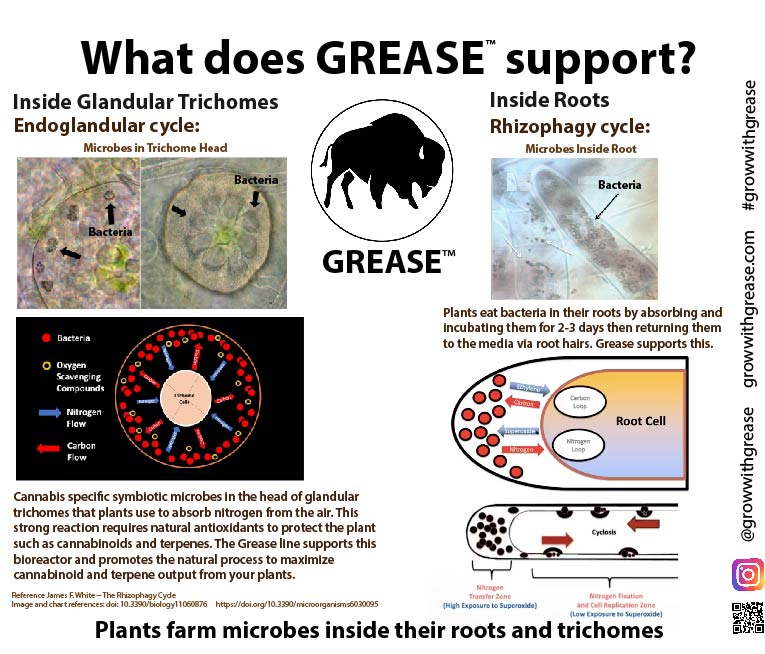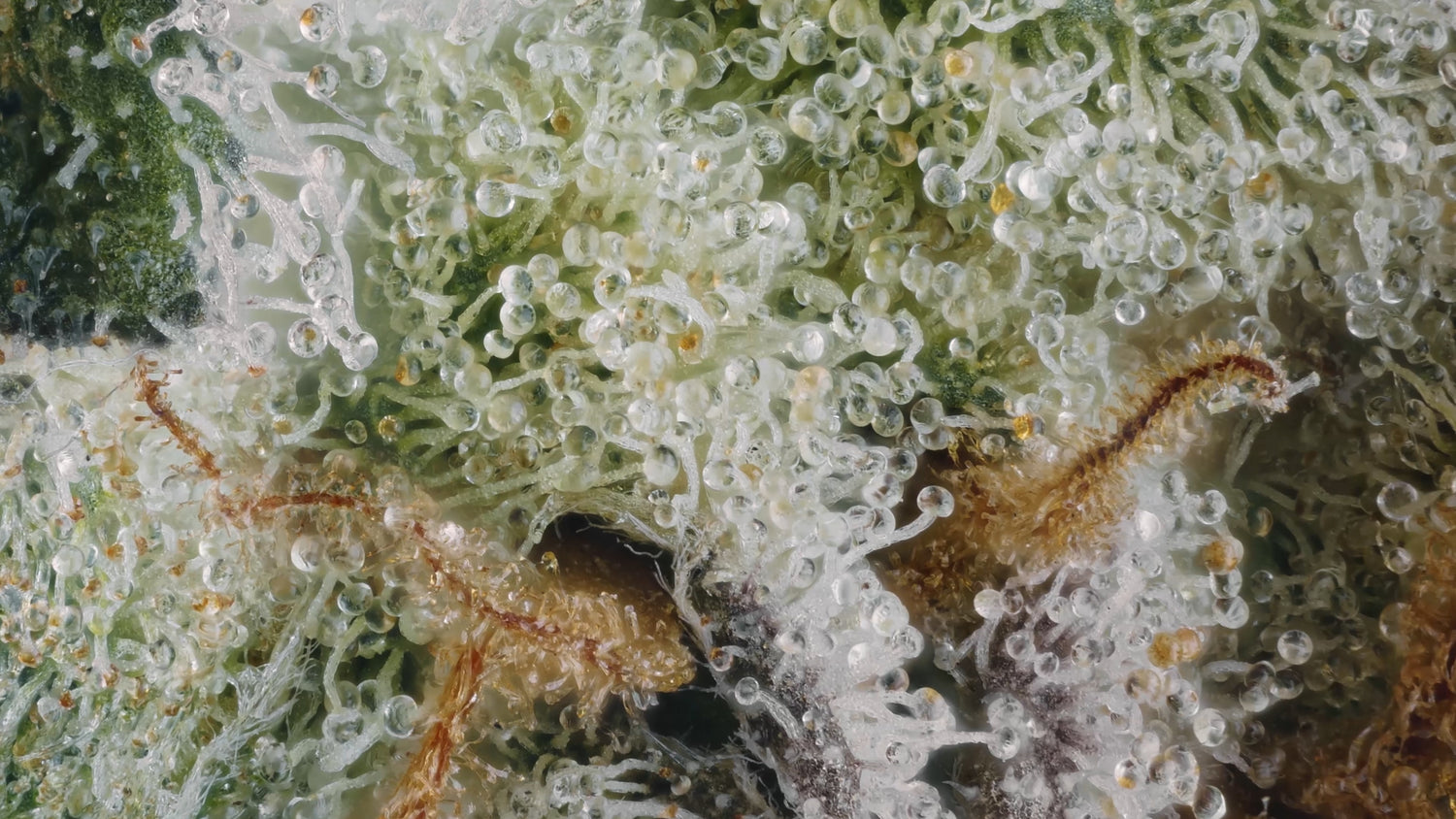How It Works
GROW YOUR PLANT WITH GREASE™

GREASE™ is an all natural product that uses the power and essence of the Cannabis plant in a trade secret, proven formulation to boost the potency of your Cannabis garden. Regular, even daily use of our product will not cause irregularities or homogenization in your genetics. Enhance and help your natural genetic expression. Works excellent on farms and gardens with multiple strains or monocrops.
GREASE™ has been laboratory tested by a Certified Lab and found to leave no harmful residue. See test results posted. Be clean and recycle.
RESIN DEFENSE™
Boosting the potency is increasing your resin exuded by specialized glands. This is proven in the heavier washes and nug runs that professional extractors are seeing across the board after regularly applying GREASE™. Increasing resin is a very helpful mechanism that Cannabis produces readily when provided the proper constituents in the correct amounts. These resinous compounds defend against desiccation, temperature extremes, and may of other benefits. By applying the consortium of precursors, the specialized compounds in GREASE™, they are immediately absorbed and redirected to resin and cannabinoid production sites.

CANNABINOIDS
The cannabinoid extracts are bioavailable through the leaves and roots. The cannabinoids are naturally absorbed into the plant leaves, trichromes and root hairs. The cannabinoid extracts provide the building blocks for cannabinoid production. According to a textbook on hemp, Cannabis plants uniquely produces high cannabinoids, a family C21 terpenophenolic compounds including THC, cannabidoil (CBD), cannabinol (CBN), cannabichromene (CBC), cannabigerol (CBG) and at least 60 other cannabinoids(McPartland). Our GREASE™ line is a pioneering technology proven to be a CANNABINOID BOOSTER™ that will increase your THC or CBD by an average of 31.5%. Additional benefits are that it is safe to use in all phases of growing, and it is based on the principles of sustainable agriculture.
- Cannabinoids have been found to have a positive effect on plant growth and development. Cannabinoids and terpenoids also have been found to help the role in promoting root growth, by increasing the number and length of root hairs, and thereby increasing the surface area for nutrient absorption. Read more below >
TERPENOIDS
The unique smells of Cannabis, however, is not from cannabinoids, but from terpenoids. Terpenoids are polymers of a C5 isoprene precursor, such as the monoterpoids. Cannabis produces over 150 terpenoids. (McPartland) It is important to note that terpenes are completely different compounds than cannabinoids. SEE MORE BELOW.
HOW IT WORKS IN SOIL/COCO
The scientific research shows the functionality of GREASE™ be considered a soil conditioner. The Molarity of Ethanol Droplet(MED) test for water repellency rating of soil proves the addition of Grease will increase the severity of reaction and aid in the breakdown of surface tension of the soil. The control showed no apparent severity. With the addition of Grease, cannabinoid latent ethanol miscible in water, the change in soil hydrophobicity resulted in a clear improvement in the water repellence rating or hydrophobicity of soil or coco fiber.
Cannabinoids can have a number of effects on soil characteristics. One potential effect is on nutrient availability, as cannabinoids can bind to minerals and organic matter in the soil, making them more available for plant uptake. Additionally, cannabinoids may have an help impact on soil microorganisms, including bacteria and fungi, which can in help affect the overall health and fertility of the soil.
Recent research has suggested that the presence of cannabinoids in the soil can help to improve the biosynthesis pathways in the cannabis plant, including the pathways that lead to the production of terpenes. Studies have found that the presence of cannabinoids in the soil can help to increase the activity of the enzymes responsible for converting OA into CBGA. This, in turn, can lead to increased production of other cannabinoids, including tetrahydrocannabinolic acid (THCA) and cannabidiolic acid (CBDA).
HOW IT WORKS IN HYDRO
It is very unique to find a product that is truly safe to use in hydroponic production. We use green and clean technology that is medical grade to ensure no contamination of your hydroponics system. It does not affect the stability of pH. Apply with every reservoir change as it is readily absorbed.
Cannabinoids can help to improve the efficiency of these hydroponic systems by promoting the growth of beneficial microorganisms, which can help to break down organic matter and release nutrients back into the system. Additionally, the increased root development can lead to better nutrient uptake, which can lead to healthier plants and higher yields.
Cannabinoid compounds have been found to have a positive effect on plant growth and development. Terpenoids have been found to have a role in promoting root growth, by increasing the number and length of root hairs, thereby increasing the surface area for nutrient absorption. Flavonoids, also found in trichomes, have been found to have a role in promoting shoot growth, by increasing the number of leaves and branches.
These findings are supported by studies such as "Terpenoids and flavonoids in the plant defense against herbivores and pathogens
BIOMIMICRY
BIOAVAILABILITY
BIODIVERSITY
Ecosystem management is an intrinsic phenomenon that explains the harmonious overlap of habitats and interconnectivity across species. Cutting out harsh chemicals in manipulated environments is critical for maintaining the species we have. You are part of the solution and no act is too small to clean up the Earth we share.
UNDERSTANDING MORE ON HOW IT WORKS

References:
- Gómez-Gómez, L., & Boller, T. (2000). Fungal elicitor perception in plants. Annu. Rev. Plant Physiol. Plant Mol. Biol., 51(1), 121–157. doi: 10.1146/annurev.arplant.51.1.121
- Ruytinx, J., Parizot, B., & Colpaert, J. V. (2010). Flavonoids and their role in the rhizosphere. Plant Soil, 329(1), 1–17. doi: 10.1007/s11104-009-0109-6
- López-Ráez, J. A., García-Sánchez, F., del Amor, F. M., & del Amor, F. M. (2010). Role of flavonoids in the rhizosphere. Plant Soil, 329(1), 19–30. doi: 10.1007/s11104-009-0110-z
- Zamioudis, C., & Pieterse, C. M. (2012). Plant-microbe interactions in the rhizosphere. Plant Cell Environ., 35(7), 1085–1094. doi: 10.1111/j.1365-3040.2012.02490.x 5.Vendan, R. S., & Prasad, K. N. (2015). Role of flavonoids in plant growth and their biosynthesis: A review. J. Plant Interact., 10(1), 1–16. doi: 10.1080/17429145.2014.954986
Cannabis Plants
Cannabis plants are known to produce a wide range of chemical compounds, including cannabinoids, terpenes and flavonoids. These compounds are produced by specialized structures called trichomes, which are found on the surface of the plant. Some trichomes are glandular and contain high concentrations of these compounds, which play an important role in protecting the plant from herbivores and pathogens, as well as attracting beneficial insects and animals.
Cannabinoids and terpenes are produced by the cannabis plant via biosynthesis pathways. It's known that the biosynthesis of cannabinoids is mediated by enzymes that convert olivetolic acid (OA) into cannabigerolic acid (CBGA) and then further into other cannabinoids.
Research has suggested that the presence of cannabinoids in the soil can help to improve the biosynthesis pathways in the cannabis plant, including the pathways that lead to the production of terpenes. Studies have found that the presence of cannabinoids in the soil can help to increase the activity of the enzymes responsible for converting OA into CBGA. This, in turn, can lead to increased production of other cannabinoids, including tetrahydrocannabinolic acid (THCA) and cannabidiolic acid (CBDA). There is many biosynthesis pathways.
In addition to impacting the biosynthesis of cannabinoids, the presence of cannabinoids in the soil may also help to improve the production of terpenes. Research has found that the presence of certain cannabinoids can help to increase the activity of the enzymes responsible for the production of terpenes, leading to increased levels of these compounds in the plant.
References:
- Zuardi, A. W., Crippa, J. A., Hallak, J. E., Bhattacharyya, S., Atakan, Z., Martin-Santos, R., … & Guimarães, F. S. (2009). Cannabidiol, a Cannabis sativa constituent, as an antipsychotic drug. Brazilian Journal of Medical and Biological Research, 42(4), 557-565.
- Russo, E. B. (2011). Taming THC: potential cannabis synergy and phytocannabinoid-terpenoid entourage effects. British Journal of Pharmacology, 163(7), 1344-1364.
- De Meijer, E. P., Hammond, K., & Parks, L. E. (2003). Variation in Cannabis sativa L. cultivars. Euphytica, 129(3), 335-344.
- de Moor, C. H., Verpoorte, R., & Verhoeckx, K. C. (2015). Cannabis in the Netherlands: past, present, and future. Journal of Biological Chemistry
Terpenes
Terpenes like cannabinoids are important nutrients for plants, and they are typically absorbed by the root system through a process called uptake. The roots of plants have small outgrowths called root hairs that are responsible for absorbing nutrients, including fatty acids, from the soil. Root hairs are covered in a thin layer of mucilage, a gel-like substance that helps to trap soil particles and nutrients, including fatty acids.
When a root hair encounters a soil particle that contains fatty acids, the fatty acids are drawn into the root hair by a process called diffusion. Diffusion is the movement of molecules from an area of higher concentration to an area of lower concentration. In this case, the fatty acids in the soil have a higher concentration than the fatty acids inside the root hair, so they diffuse into the root hair.
Once inside the root hair, the terpenes are transported across the plasma membrane of the root hair cell by specific transporters. These transporters are responsible for pumping the fatty acids across the membrane and into the cell where they can be used by the plant.
The terpenes are then transported to the plant's other organs and cells, where they are used for various purposes such as energy storage, as building blocks for the membranes, in biosynthesis of different compounds and even as signaling molecules. It's also worth mentioning that some plants can also obtain fatty acids from microorganisms. This process called Rhizophagy, where the plant can host specific microbes that are capable of producing or hydrolyzing fatty acids and then the plant will use these compounds.
References:
- "Fatty acid uptake by plant roots" by W.P. Quick, Plant and Soil, vol. 199, pp. 149-161, 1998.
- "Transport of fatty acids across plant cell membranes" by J.L. Harwood, Journal of Experimental Botany, vol. 45, pp. 1065- 1075, 1994.
- "Root hair uptake of lipids in plants" by K. Vermaas and A.A. Hoffland, Plant and Soil, vol. 314, pp. 195-205, 2009
- "Rhizosphere-microbe-plant interactions: complementary insights from the Rhizosphere Carbon Flow and Microbe-Root Interaction networks" by K.S. Pregitzer, Plant and Soil, vol. 391, pp. 1-16, 2015.
- "The Role of Microbes in the Rhizosphere of Plants: Implications for Phytoremediation" by S.G. Petrovic, R.D. Finkelstein and J.M. Suflita, Biotechnology Advances, vol. 29, pp. 185-197, 2011.
Trichromes Are Nutrient Making Farmers
Trichomes, like root tip hairs, can help to farm beneficial bacteria on the surface of the plant. Root tip hairs, also called root hairs, are elongated outgrowths of the root epidermis that help to increase the surface area of the root for absorption of water and nutrients. Similarly, trichomes also increase the surface area of the plant and provide a favorable environment for the growth and colonization of beneficial bacteria.When plants produce exudates and secretions, it creates an environment that is favorable for microbes, like bacteria, to colonize. These exudates, which are rich in sugars, amino acids, and other nutrients, can act as a food source for beneficial bacteria. Additionally, certain compounds produced by trichomes, such as certain terpenes, can also help to attract beneficial bacteria to the plant.Once the beneficial bacteria colonize the surface of the plant, including the trichomes, they can help to improve the plant's ability to take up nutrients from the soil. This is achieved by a variety of mechanisms, including the fixation of nitrogen, solubilization of phosphorous and chelation of micronutrients, which help to make these essential nutrients available for the plant.This mutualistic relationship between plants and bacteria is referred to as rhizosphere and this process, specifically the one in trichomes is known as rhizophagy, which is the ability of a plant to feed on microbes living in or around its roots or trichomes.It's important to note that more research is needed to fully understand the mechanisms behind this relationship, but studies have shown that the ability of trichomes to farm beneficial bacteria can lead to improved plant growth, increased nutrient uptake, and better defense against pathogens.
References:
- White, J. F. (2016). The rhizophagy cycle: how plants get nutrients from microbes. Microbe, 11(2), 49-55
- Gaffal K, Weiler EW. Trichomes of higher plants: diversity, development, and secretory functions. Plant Biol. 2017;19:735–46.
CANNABINOIDS HELPING SOIL
- Cannabinoids may help to increase the production of root exudates by activating certain genes involved in the biosynthesis of these compounds.
- Cannabinoids may help to improve the quality of root exudates by increasing the concentration of certain beneficial compounds, such as sugars, amino acids, and enzymes.
- Cannabinoids may help to protect the plant roots from pathogens by increasing the production of antimicrobial compounds in the root exudates.
- Cannabinoids may help to improve the absorption of nutrients by the plant roots by increasing the production of enzymes and other compounds that can break down complex compounds in the soil.
Check out some relative science a our FAQ page
COMMON SENSE CAUTION:


